Easter Island is one of the world’s most remote and mysterious places, a tiny isle in the Pacific with a big story. Get ready for some unforgettable outdoor adventure and Rapanui culture with our 6-Day Easter Island itinerary.
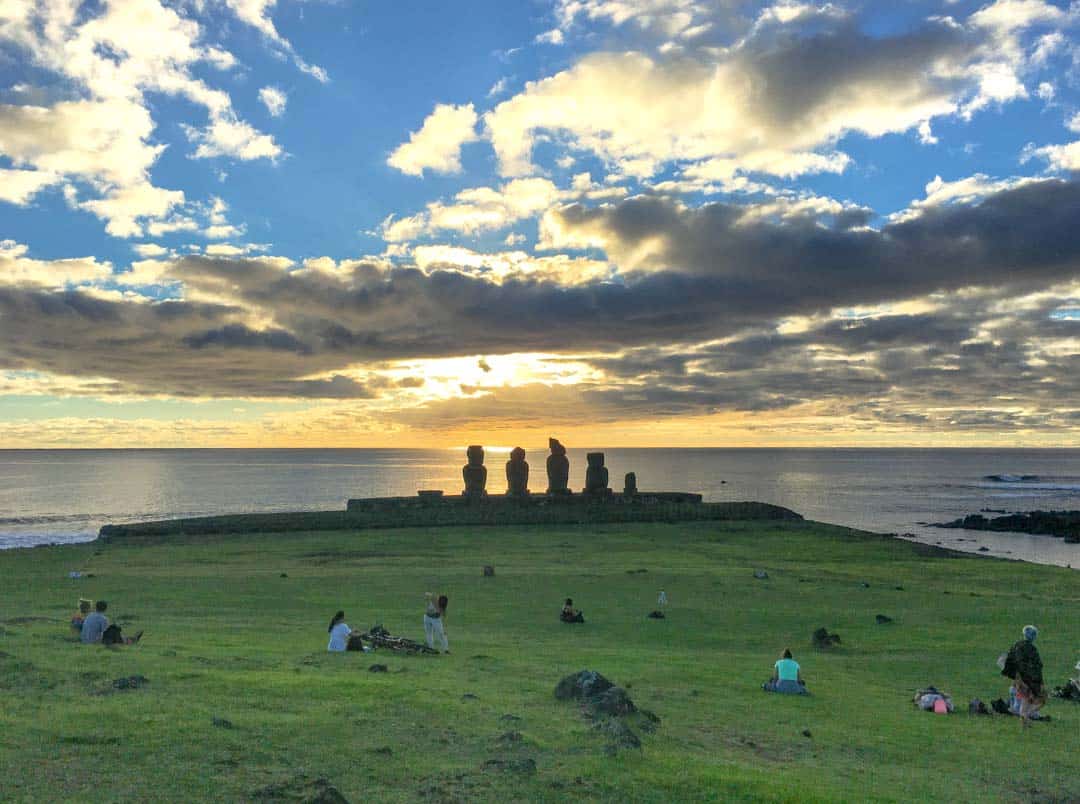
Your first encounter with a moai, the enigmatic stone sentinels of Easter Island, is one you’ll never forget.
For us, that moment came right on sunset, just as the rays of the dying sun exploded in a starburst between the stoic heads of Ahu Vai Ure. We’d just arrived on this tiny isle, a speck of grassy hills and rocky coastline in the middle of a vast, blue ocean.
Now, as we watched the sky turn fuscia above the carved giants, just as it has for hundreds of years, we had to pinch ourselves. Easter Island had been a lifelong dream destination, and we were finally, really, here.
For many people, Easter Island is a quick side trip from Chile’s capital, Santiago. Maybe 3 or 4 days at most. But to really experience this unique isle – to discover the story of its fraught past, its transformed landscape, and its fascinating modern culture – Easter Island really deserves longer.
In our 6-Day Easter Island itinerary, we get our outdoor adventurer on and explore the island by foot, bicycle and hire car. We also venture into its crystal clear waters for some scuba diving.
If you love being outdoors and active and if, like we did, you want to see as much of this unique Pacific island as you can, then pack your outdoor gear and get ready for a destination like no other.
IMPORTANT UPDATE: It is now mandatory for all visitors to Easter Island to have a local guide with them when they visit any of the archaeological sites in Rapa Nui National Park, except Ahu Tahai near Hanga Roa, and Anakena Beach on the north-east coast. This is in addition to the National Park entry fee.
We’re currently looking into how this impacts visiting the island independently with a view to updating this post.
In the meantime, check out this website and this online guide for more information.
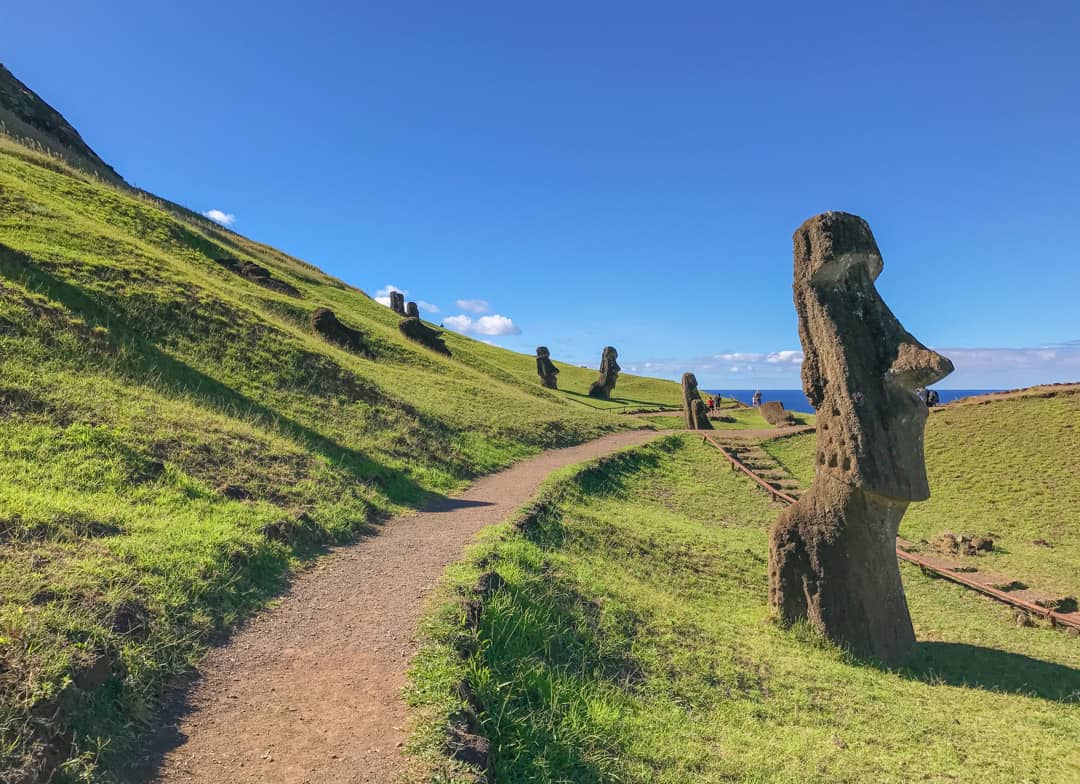
Day 1 – Arriving On Easter Island & A Moai Sunset
With its closest continental neighbour – South America – almost 4,000 kilometres to the east, the easiest way to travel to Easter Island is by plane from Chile’s capital, Santiago.
There are other ways to travel to Easter Island. With time, flexibility and money, you could consider the weekly flight from Tahiti, or visit the island as part of a South Pacific cruise ship itinerary.
Flying To Easter Island
Easter Island is a territory of Chile, and LATAM is the only airline servicing the island.
Chile’s capital, Santiago, is LATAM’s international hub, so unless you’re coming via Tahiti, if you’re flying to Easter Island, you’ll be departing from Santiago.
Santiago is a fantastic city in its own right, and we highly recommend using your stopover to get out and explore.
If you’re after some inspiration, hit up our post on 20 cool things to do in Santiago.
In our case, we planned our Easter Island trip as part of a longer journey through South America, using Santiago as our base.
We gave ourselves a tonne of time to get to Santiago airport on the day of our flight to Easter Island. Not that it mattered. Shortly after checking in, our scheduled 9.30am flight was delayed due to weather.
Travel Tip: Factor in extra time in case your flights to Easter Island are delayed
Located as it is in the middle of
nowherethe Pacific, Easter Island is subject to the whims of ocean weather, and flights can be delayed or cancelled at a moment’s notice.Our flights to and from the mainland were both delayed due to weather.
Just one more reason why it’s worth giving yourself more time than less, plus some extra time before and after, if you’re planning a visit to this special place.
By the time our plane finally hit the tarmac at Mataveri International Airport on the island, a little over five hours after taking off, the afternoon sun was already dipping towards the horizon.
Welcome To Easter Island!
Known in Spanish as Isla de Pascua, one of the first things you’ll notice when you arrive is the unique mingling of Rapanui and Spanish culture on the island.
The Rapanui were the original settlers of Easter Island, arriving from other Pacific islands more than a thousand years ago.
Following waves of destructive European contact and colonisation in the 18th and 19th centuries, Easter Island was annexed by Chile in the late 19th century. By that stage, the Rapanui population on the island had been reduced to just over 100 people.
Today, Spanish is the official language of Easter Island, but the Rapanui culture and language lives on through the descendants of those people. We speak very (very!) basic Spanish, but we found most people we met, particularly in the hospitality and tourism businesses, also spoke English.
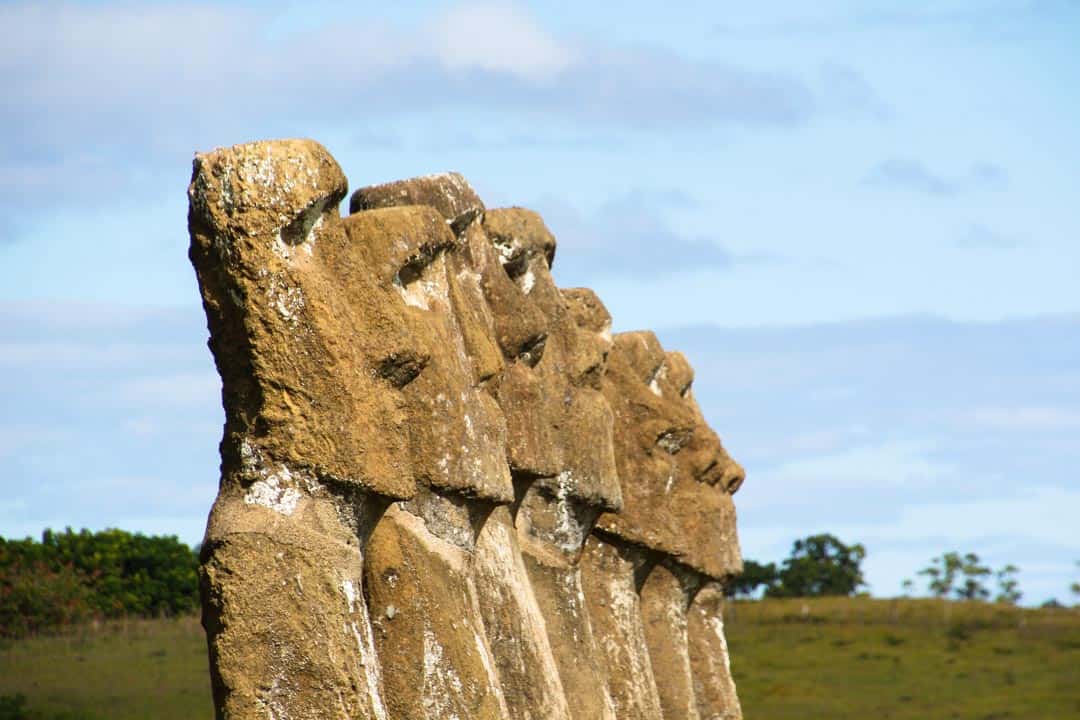
Buy Your Rapa Nui National Park Ticket At The Airport
Before you leave Easter Island’s airport, stop by the CONAF booth and buy your Rapa Nui National Park entry ticket (CONAF is the organisation that manages Chile’s national parks).
This saves the hassle of sorting out your ticket later, though you can also pick one up at the Ma’u Henua Indigenous Community Central Office on Atamu Tekena Street in Hanga Roa (the only town on the island), or at the CONAF office in Mataveri.
The Rapa Nui National Park ticket is US$80 for foreign adults and US$40 per child, and it’s valid for ten days from the first entry stamp.
While you’ll only have your ticket stamped at a couple of sites around Easter Island, you can be asked to show your ticket at any time while you’re within the park. And as almost half of the island is national park, your best bet is to carry your ticket with you throughout your stay.
“Do I have to buy the Rapa Nui National Park ticket?”
We’ve been asked this question several times: is there a way to get around the Rapa Nui National Park entry fee?
We get it, it’s steep, and yes it’s frustrating that the ticket grants only one-time entry to two of the most incredible sites on the island (Rano Raruku and Orongo Ceremonial Village).
But our position is this: Easter Island is one of the world’s great historical and cultural treasures. If you’re making the effort and spending the money to travel all the way to this remote corner of the world, then spending a bit more to help support the protection and maintenance of its fragile environment and extraordinary artefacts is the least that we as travellers can do.
Check In To Your Accommodation
Once you’ve collected your bags and purchased your park pass, make your way to your accommodation and settle in.
Easter Island accommodation is available at a range of price points, from camping and hostel options to luxury resorts. Most stays are located in and around Hanga Roa, and this is a good, central spot to be.
We opted to stay in a small, self-contained cottage a half-hour’s walk from the centre of town. It meant we could save money by self-catering when we felt like it, and wander into town for dinner via the coast and a handful of the island’s famous stone statues, the moai.
We also had gorgeous sunsets from our front verandah; the perfect spot for winding up busy days with a bottle of locally brewed Mahina Pale Ale.

Experience Sunset At Tahai Ceremonial Complex
Once you’ve dropped your bags, if you have time for a quick wander around Hanga Roa, then go for it (and maybe take the opportunity to pick up some food from the supermarket in town if you’re self-catering). But aim to be on the hillside above the Tahai Ceremonial Complex, just north of town, before sunset.
As the nearest moai platforms to Hanga Roa, this collection of statues and ahu(stone shrines) is the most popular sunset spot for visitors and locals on the island.
This was our first real encounter with Easter Island’s mysterious moai. With their backs to the ocean and their eyes turned skyward, the clouds above turning pink and purple, and golden rays of light glancing between the stone heads, this was the moment for us when the magic of Easter Island really took hold.
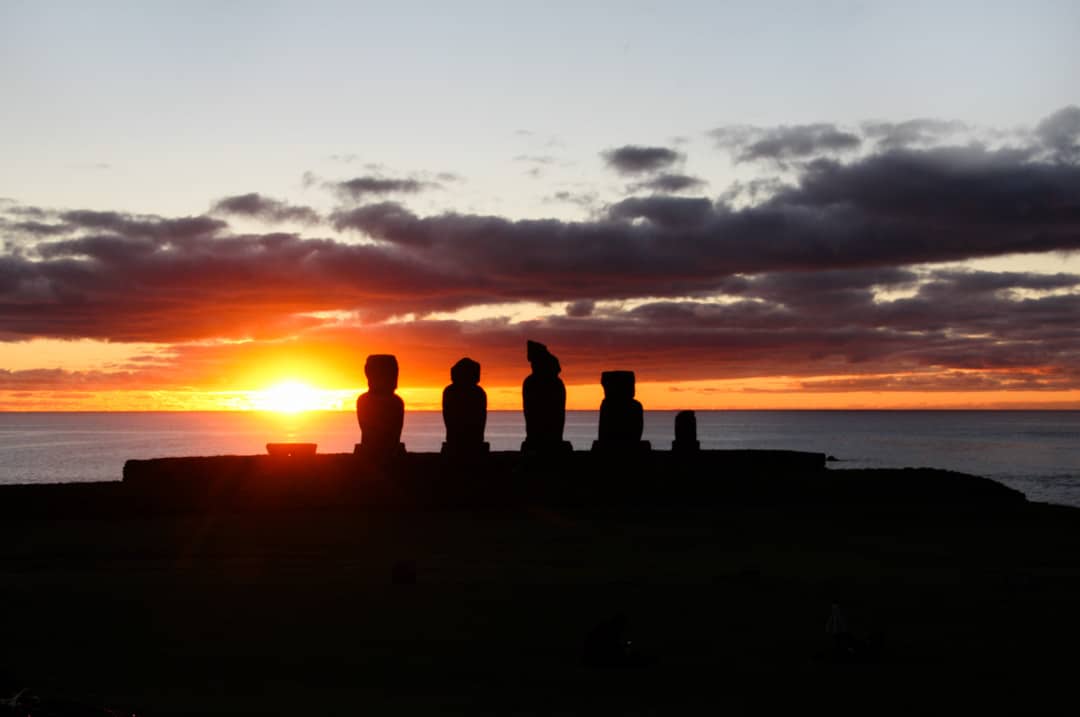
Once twilight has settled in, make your way back to Hanga Roa for dinner. You’ll find a range of eating options around town serving up everything from fresh seafood (tuna steak is a tasty staple on the island), to Chilean specialties and good ol’ fast food like pizza and burgers. Given most things need to be shipped in to Easter Island, eating isn’t cheap – a ‘budget’ main will still set you back around US$20.
Day 2 – Explore Easter Island’s Centre & West By Pedal Power
Greet The Sun With A Moai
If you’re staying near Hanga Roa, we recommend starting Day 2 back down by the moai of Ahu Tahai for dawn.
Watching as the sun peeks over the high hills and creeps up the stone to light the restored white coral eyes of the moai on Ahu Ko Te Riku sends tingles up the spine.

Organise Your Easter Island Bike Rental & Hit The Road
After an early breakfast, head into Hanga Roa and collect some basics for a packed lunch. Make sure you have lots of water too.
If you’re into scuba diving, this is a good time to drop by the dive centres down by Hanga Roa harbour to book in some diving for tomorrow.
Next, make your way to Atamu Takena Street and hire a couple of bicycles for 24 hours. There are several stores in Hanga Roa where you can hire bikes, including a place where you can pick up battery powered ebikes.
Once you’ve checked bike tyres and adjusted seats, start pedalling out of town towards Anakena along Camino Vaitea Anakena.
As you cruise through the countryside, watch out for a left turn called Pia Taro. Just down here is a lonely inland moai, Ahu Huri A Urenga, which is famous for having four hands. This moai is also perfectly aligned to watch the winter solstice sunrise.
We only stopped here briefly, but there was a wonderful ambience as we took in the scene: just us, our stone friend, and hundreds of dancing dragonflies.
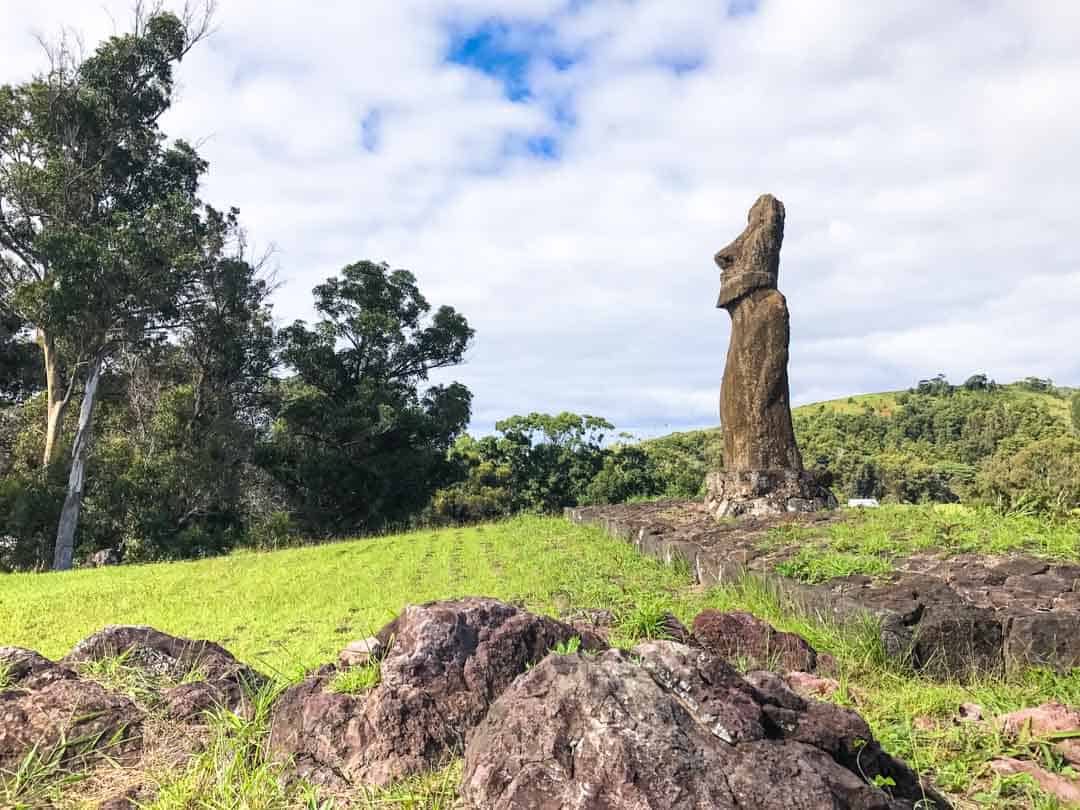
Back on the main road, keep pedalling through the rolling landscape, watching out for glimpses of the sea across fields of yellow flowers. You’ll soon come to the corrugated iron remnants of a historic farm, the Instalaciones Historicas del Fundo Vaitea.
Just near here, on the left, is a path that leads into the woodland and up to Maunga Terevaka.
Make The Climb To Easter Island’s Highest Point
Don’t be deceived by the gently sloping rise ahead: the peddling gets decidely tougher as you power up this 507-metre hill. We ended up dismounting and hauling ourselves panting and red-faced enjoying a slow walk with our bikes up to the peak.
Maunga Terevaka is the highest point on Easter Island and from the top, you’ll have epic panoramic views across the entire island.
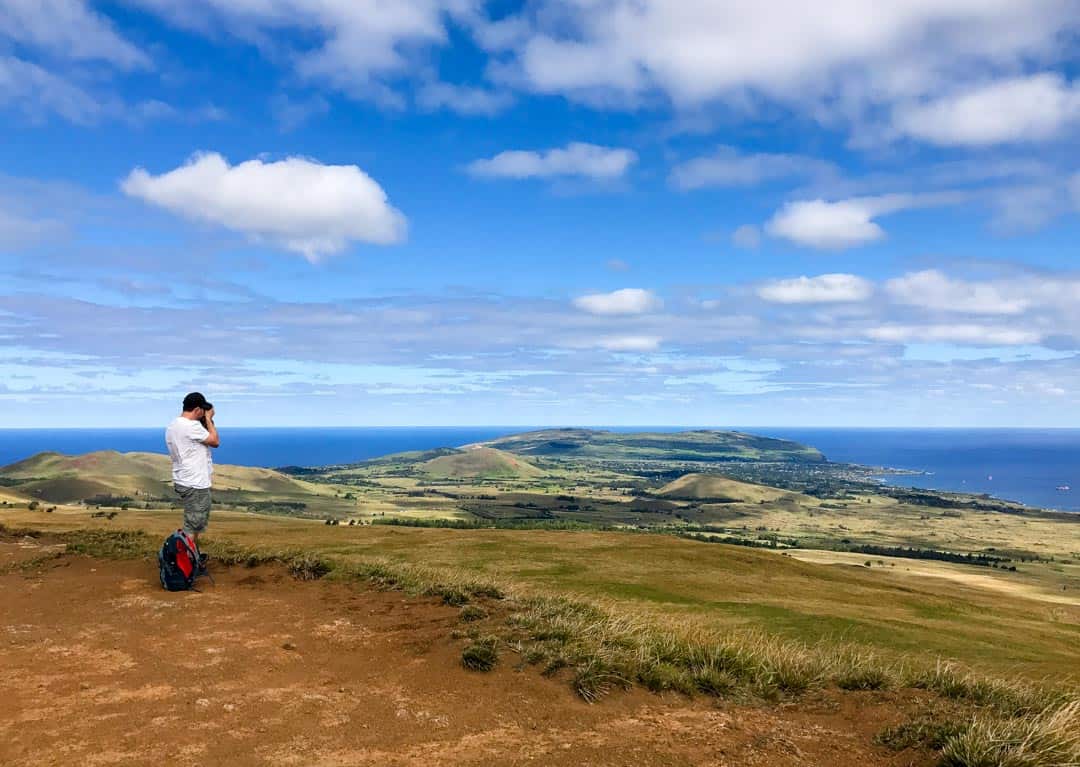
It’s a great spot to stop for lunch and ponder the profound isolation and history of this remote island surrounded by sea. You may also be joined at the top by riders who’ve made the journey up on horseback.
The ride back down the other side of Maunga Terevaka is much easier and a bit of a thrill as you feel the wind in your hair.
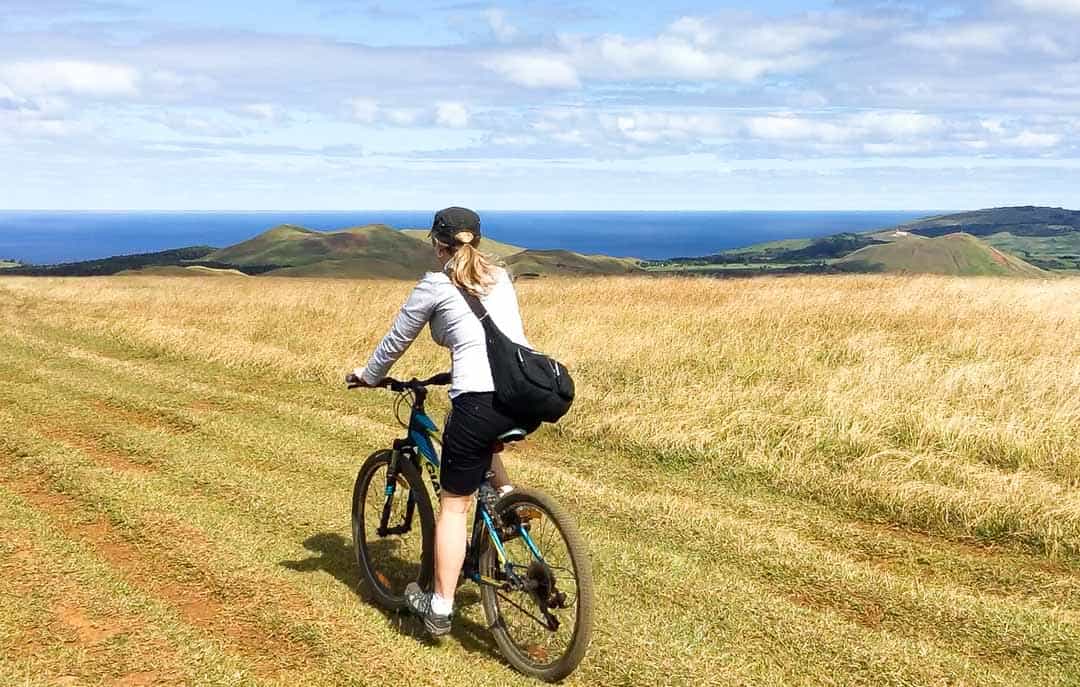
Sense The Past At Shrines, Ruined Villages & Caves
At the base of Maunga Terevaka, follow the path to Ahu Akivi, where seven moai maintain a timeless watch over the landscape.
Akivi is considered unusual in that its moai seem to be facing the sea, rather than having their backs to the ocean. Actually, the sea is a couple of kilometres away and, like all moai, they were erected to watch over their village, which in this case was further inland than others.
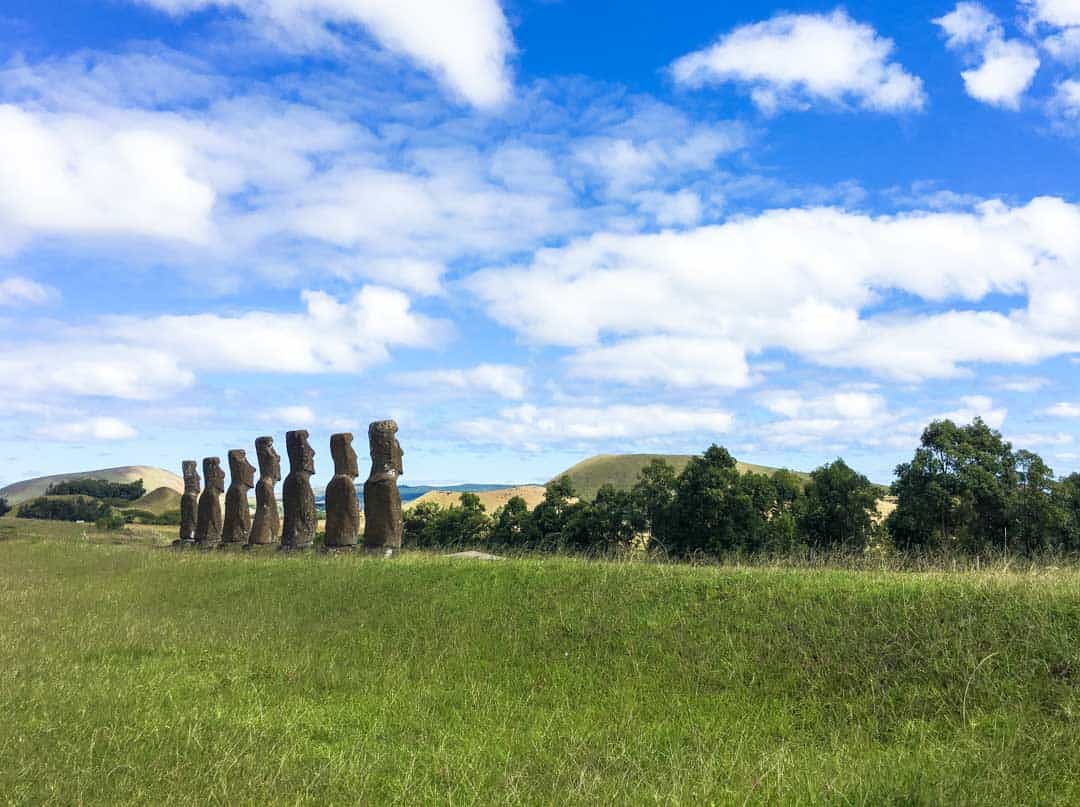
From Akivi, it’s a short ride west to the awesome underground space of Ana Te Pahu.
This vast cave, remnants of a lava tube, was a home and refuge for Rapanui people back in the day. You can still see vestiges of their lives here, like stone ovens and veggie gardens, where banana trees and avocados still grow.
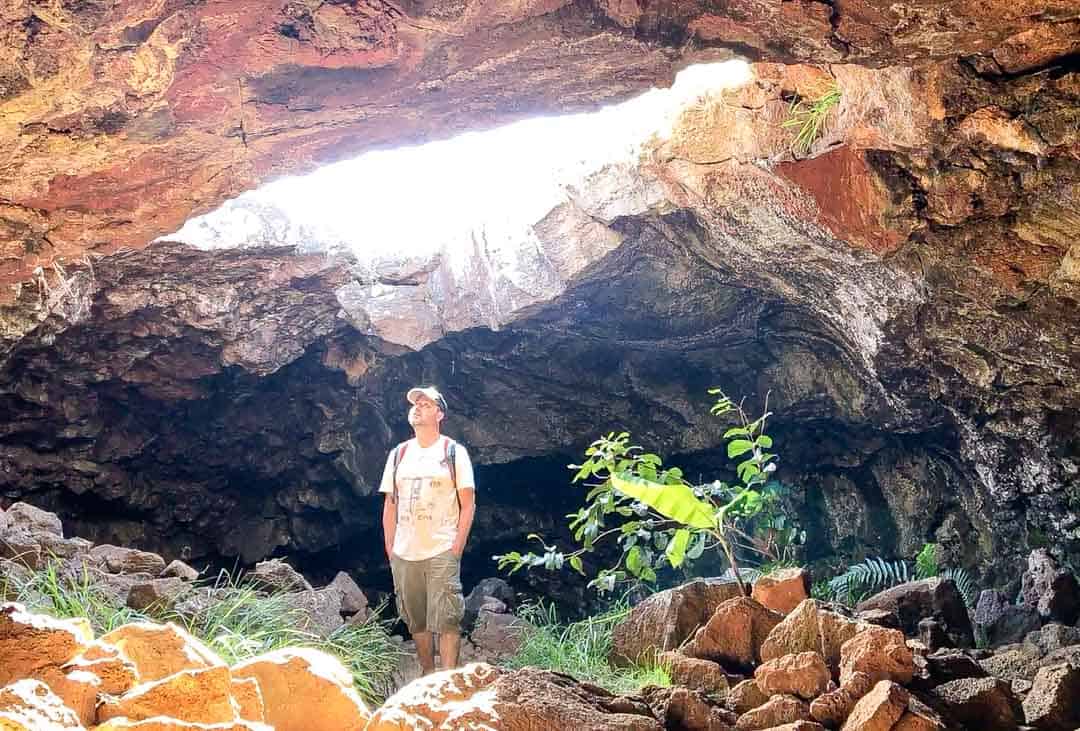
Onwards and towards the coast, watch out for our next stop: Ana Te Peu. This was once a large and thriving Rapanui village.
Wander the ghostly ruins, keeping an eye out for the circular stone walled gardening plots, the elliptical hut foundations, and the impressive ahu platform (go around to the ocean-facing side to see the best of its beautiful masonry).

The road gets quite bumpy and rocky along the coast here, so take it easy as you continue pedalling south.
Our next stop is another cool cave called Ana Te Pora. This was also a refuge of sorts for the Rapanui people, who were often at war for dominance over the island and its dwindling resources by the 19th century.
There’s a strange, flat stone platform in this cave. Some reckon it was a bed, but it wouldn’t have been a particularly comfy one.
Our last stop along the rubbly trail back to Hanga Roa is Ana Kakenga, a narrow cave that opens out on two fronts in a cliff face overlooking the ocean.
Blink and you might miss the entrance, but if you don’t mind small spaces, crawling into this one is worth it just to feel for a second like a Goonie on a great adventure.
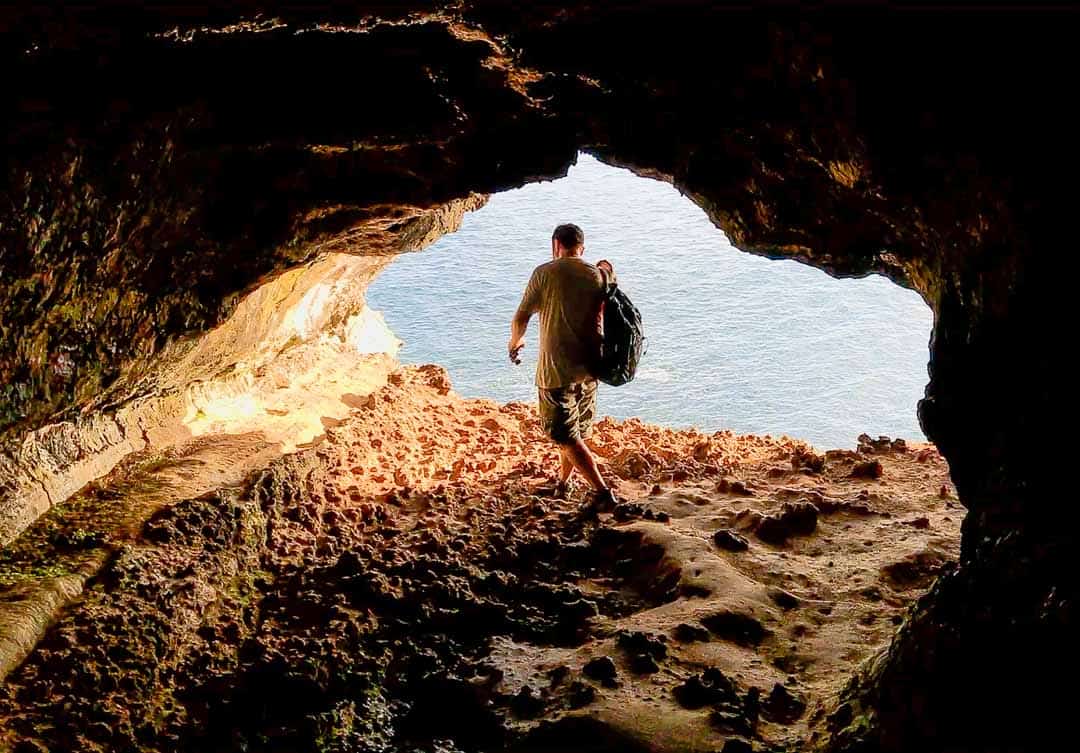
As you pedal the last stretch along the coastal track back to Hanga Roa, look out for the moai at Ahu Akapu. Then continue on back to your hotel for a well-earned shower and a cold beer.
This is a huge day, but you’ll feel pretty buzzed by the end of it, and exhausted. After rolling back into our stay, we watched the sun go down from our porch, then pulled together a meal from our fridge before passing out for the night.
What are the ‘ahu’ and ‘moai’ of Easter Island?
‘Ahu’ is the Rapanui name for the stone shrines located all over Easter Island. They were built by the Rapanui people, mainly between the 15th and 17th centuries.
These shrines, of which there are literally hundreds in various states of ruin and repair, usually consist of a stone platform with a sloping cobbled ramp and a flat space in front.
Some ahu were topped with stone statues, the famous Easter Island heads called ‘moai’. Thought to represent ancestors, there are said to be close to a thousand moai around the island.
Historical records suggest most, if not all of the moai had been pulled down or destroyed through clan wars by the close of the 19th century.
Today, the standing moai you see around the island have been re-erected and restored to their former glory.
Day 3 – Scuba Dive Easter Island’s Underwater World
Get Beneath The Surface Of Rapa Nui
After yesterday’s epic effort, today is a little more low-key, although we’re still getting out for some Easter Island adventure. This time, it’s under the waves.
Getting to bed early means you’ll be nice and fresh for another dawn with the moai. Take your pick of sites if you have a car, but if you’re near Hanga Roa, head to Hanga Kio’e and the Akapu moai for sunrise.
After brekkie, cycle into town and return your hire bikes. Then head over to your chosen scuba dive centre down by Hanga Roa harbour.
We opted to do our Easter Island diving with Mike Rapu Dive Centre and they were awesome. Having booked the day before, it was a smooth check-in and by 8am, we were geared up and ready for our two boat dives.
There are a handful of dive sites around Easter Island, mainly clustered on the western side of the isle.
Marvel At A Cathedral
Our first dive, at a site called Cathedral, was a 20-minute boat ride from Hanga Roa, a great experience in itself for seeing the island from the water.
Cathedral is a cavern dive, and we were served a beautiful show of light as the sun twinkled through the rocks.
The visibility was astounding and while we saw very little fish life, the sponges and corals were healthy and eye-catching, and we had a fun surge on the day we dived.

Meet The Underwater Moai
After a break, we made our way out for a second dive, this time to the island’s most renowned dive site: the sunken moai in Hanga Roa Bay.
The underwater moai is a modern addition to the island’s folklore, a replica that – word is – was made and submerged for an early 90s Kevin Costner film called, you guessed it, Rapa Nui. Incidentally, the film flopped (I secretly love it).
Fake this moai may be, but coming upon the big head as it rests in 23-metres of crystal clear water, slowly being reclaimed by patches of coral, is an experience you definitely won’t have anywhere else.
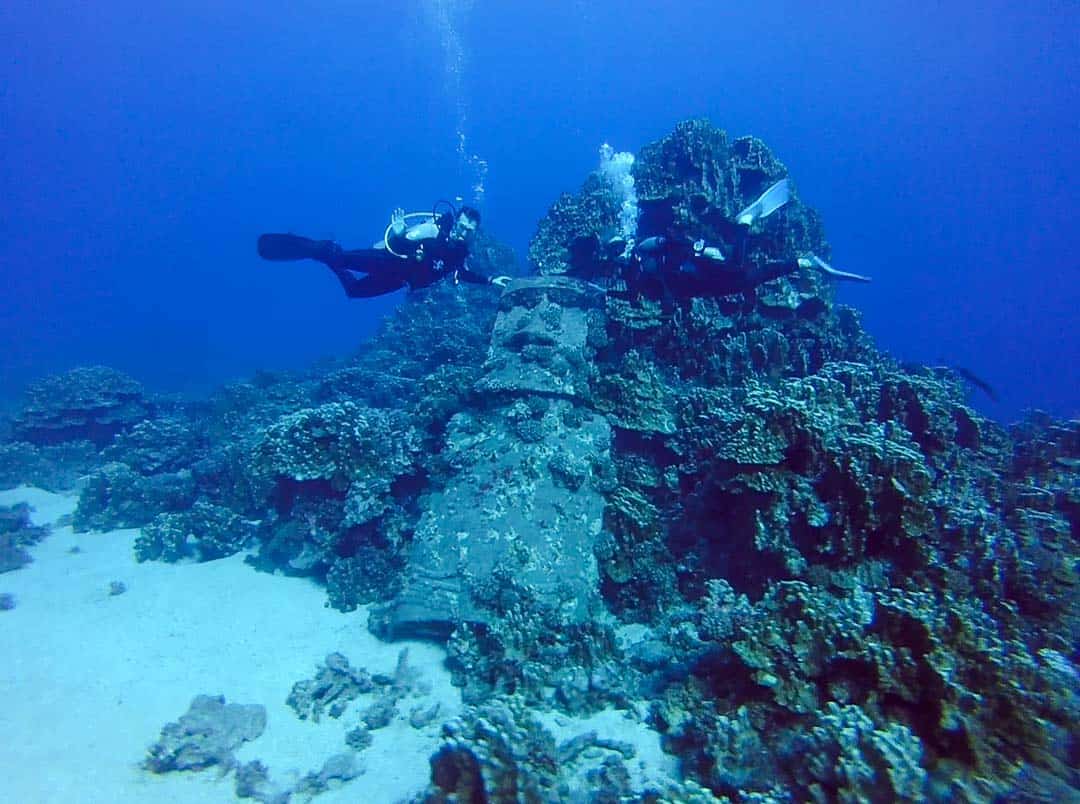
Explore Hanga Roa, Easter Island’s Only Town
After diving, head back into Hanga Roa for lunch. Diving always takes it out of us, so we spent the afternoon of Day 3 relaxing back at our cottage.
If you’ve got the energy though, then use this afternoon to check out Hanga Roa. There’s not a lot to do in this tiny town, but as the business and residential heart of the island, it’s worth a wander.
Check out the carvings at Iglesia Hanga Roa (the Holy Cross Church), a blending of fascinating Catholic and Rapanui traditions.
If you fancy buying souvenirs, there are a couple of souvenir markets in town. The Mercado Artesanal just near the church is a great place to buy art and handicrafts made by the islanders.
You could also include a visit this afternoon to the Sebastian Englert Anthropological Museum (unless it’s Monday, as the museum will be closed). Otherwise, we’re leaving this highlight till our last morning on Day 6.

Hiking The Northwest Corner – An Alternative Easter Island Adventure On Day 3
If you aren’t a scuba diver or if you’d prefer to stay dry, and you’re looking for an alternative outdoor experience on Day 3, then consider hiking Easter Island’s northwest.
There’s no road, just a track that skirts the coast around Maunga Terevaka, from where the road ends at Anakena Beach all the way back to Hanga Roa.
This is the quietest corner of the island; it’ll likely just be you, maybe another hiker or two, and the broken ahu and moai that scatter the coast here, just as they have for centuries.
We considered walking this trail in the afternoon after diving, but it’s better to set aside the whole day for this hike. We’re told it can take a good six to seven hours.
Be Captivated By Easter Island’s Traditional Dancers
Tonight, head into town for a cultural performance by one of Easter Island’s traditional dance groups.
Of all the things to do in Easter Island, this might at first seem like the one with the greatest potential to be a bit cheesy. We weren’t sure what to expect when we booked a 9pm show with Kari Kari. But we were completely captivated by the engaging, high energy performance, which brings to life the ancient language, songs, stories and dances of the Rapanui people.
There are several dance troupes on the island, performing on alternate evenings, so no matter when you’re there, chances are there’ll be a performance on somewhere.
Once you’ve decided which show you’d like to see, ask at your accommodation where to book (they may book for you); in our case, we visited the Kari Kari office in Hanga Roa in the early afternoon on the day of the show.
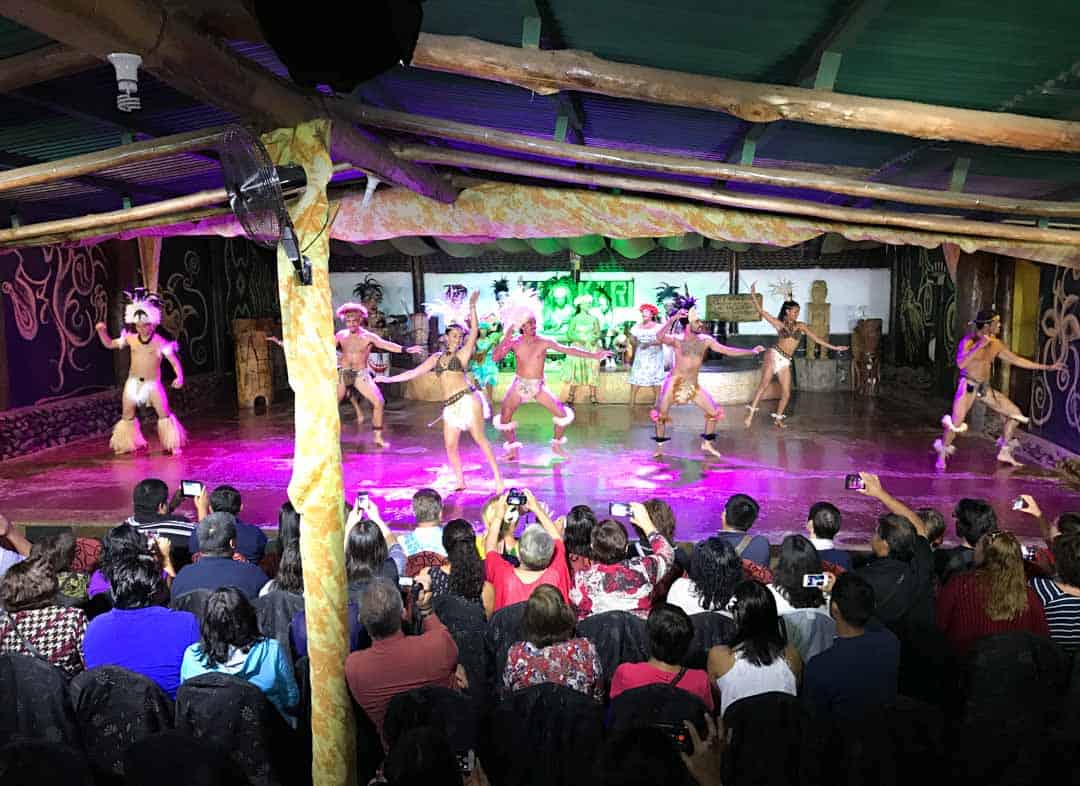
Easter Island Car Rental
Days 4 & 5 of our Easter Island itinerary involve a hire car.
To make sure we had as much time on the road as we could, we arranged a 48-hour car hire through our accommodation, and had it delivered at 7pm on Day 3. That way we were able to get on the road before dawn on Day 4.
The car hire folks brought the paperwork with them when they dropped off the car, and we completed all the formalities right there and then.
Day 4 – Road Trip Easter Island’s Northeast
Watch The Sun Rise At Tongariki
With our hire car, a cute little red jeep, delivered the evening before, we were up and on the road while it was still dark on Day 4 to be at Ahu Tongariki for sunrise.
Ahu Tongariki is, without doubt, the highlight of Easter Island’s moai sites. Fifteen giant stone statues adorn the 220m-long platform here, forever gazing inland in an incredible, unforgettable scene.
It wasn’t always so. Like all of the island’s moai, the sentinels of Tongariki had been toppled by the late-1800s as a result of clan wars, and some of them were swept hundreds of metres away from the ahu when a huge tsunami hit the island in 1960.
Today though, the restored Tongariki inspires awe once more, and it’s a truly spectacular place to welcome the morning sun. Even moreso when there are only a couple of other people there, like the morning we visited.

Wander The Ancient Quarry of Rano Raraku
From Ahu Tongariki, make your way over to nearby Rano Raraku. Alongside Tongariki, this place turned out to be our favourite on the island.
Rano Raraku was the great quarry of the Rapanui people. Just about all of Easter Island’s moai were carved from the volcanic tuff here before being transported to their ahu sites around the island.
Many more moai still remain at the quarry, half-carved and emerging from the stone, or rising up out of the hillside, partly buried forevermore on the slopes of the ancient volcano.
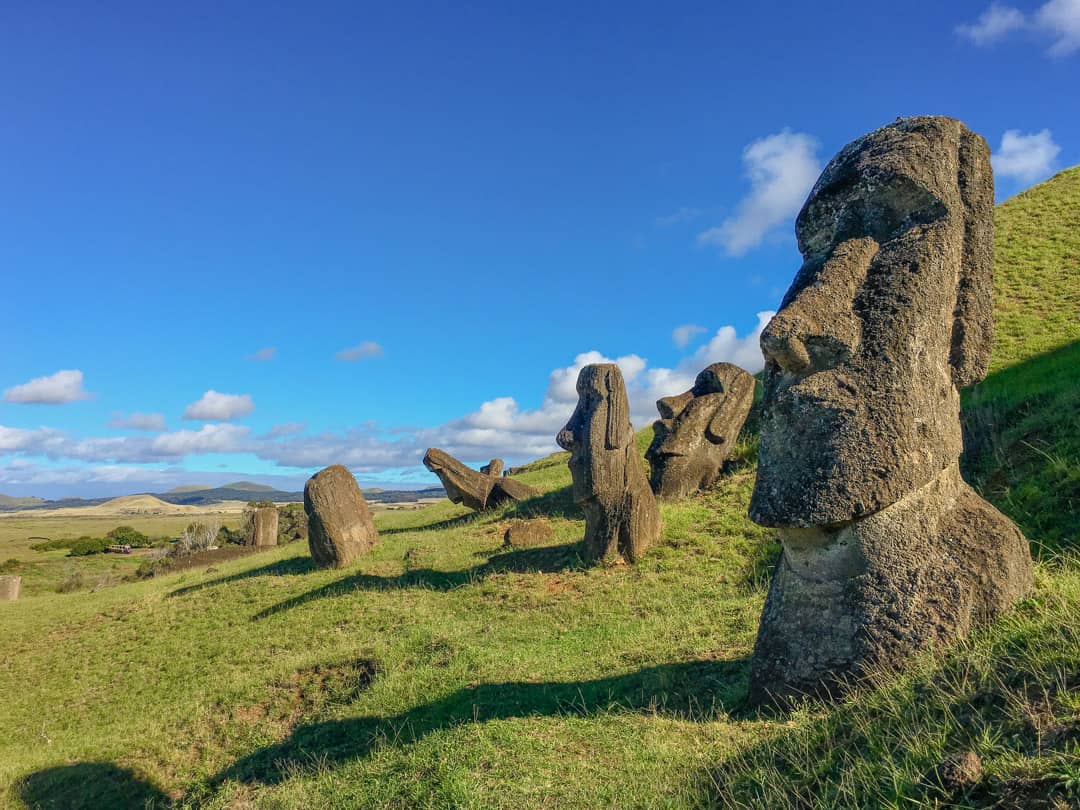
Rano Raraku is an extraordinary, mysterious place, and it’s a profound feeling wandering among the haphazard, scattered moai. The scene feels recently abandoned, as though the Rapanui were only just here, grinding away at their ancestral statues before suddenly vanishing into the mists of time.
The Rapa Nui National Park ticket gives you just one entry to Rano Raraku, so take your time here.
There are nearly 400 unfinished and broken moai visible on the hills of the quarry and if you arrive early enough, you may have a chance to ponder the moving scene with few others around.
Keep an eye out for our faves: Te Tokanga, the largest moai ever carved (but never finished, it was simply too big); Ko Kona He Roa, a moai with a three-masted ship carved onto its chest; and Tukuturi, a kneeling, round-headed moai unique among its peers.
Rano Raraku is a volcano crater. After wandering the quarry on the outer slopes, head around to the crater entrance and check out the beautiful scene within the crater itself. More moai have been quarried and abandoned in here too.
Mysterious Rock Carvings, Fallen Giants & Pristine Beaches
From Rano Raraku, we get back on the road and explore further northeast, starting with the unusual Pu o Hiro, a mysterious rock with petroglyph carvings and holes, through which a trumpet-like sound can apparently be made.
It’s thought to be an ancient instrument used for rituals, and we read somewhere that there are Rapanui locals who can ‘play’ this curious creation. Alas, there was no one on hand to demonstrate so for us, at least, this unusual rock remains an intriguing….rock.

Further on, make a stop at the petroglyph site of Papa Vaka. If the sun is still relatively low, it may be easier to make out the various sea-related carvings than when the sun is high in the sky. Look out for marine creatures like turtles and tuna, as well as curly fishing hooks, and a large double hulled canoe.
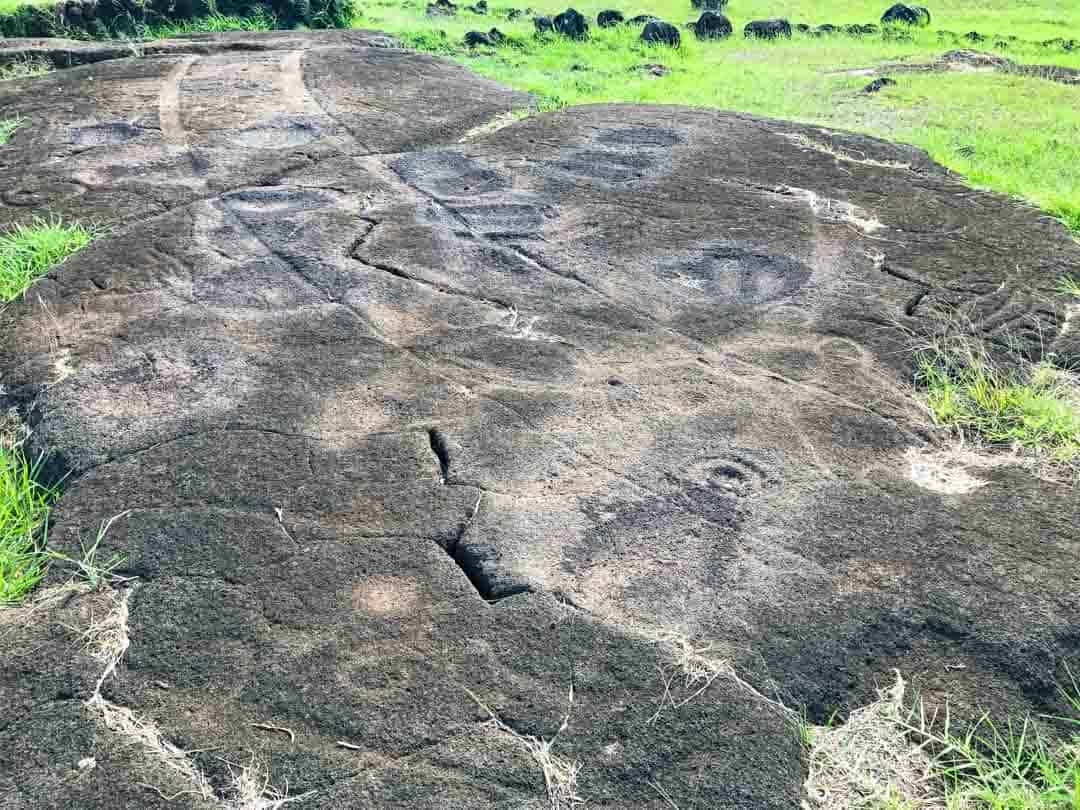
Our next stop along the north coast road is Te Pito Kura, home to Paro, the biggest moai ever to be transported and raised on an ahu in one piece. Sadly, these days the 10-metre-tall, 80-tonne Paro lies face down and broken, just where it fell so many years ago.
There’s also a strange smooth round stone here, surrounded by four smaller stones, that will apparently send your compass spinning, should you have one to hand.
We were ready for a break by this point in our road trip of the northeast circuit, so we took the opportunity to stop at one of the island’s gorgeous beaches, the beautiful Ovahe Beach, for a swim and some lunch (tip: bring a packed lunch today and tomorrow as there are few opportunities for food outside of Hanga Roa).
Ovahe, not far from famous Anakena Beach, is the quieter of the two. We laid out our towels in the shade of the sheer red cliffs that back the beach (not too close though as they occasionally shower down pebbles), and enjoyed a dip in the refreshing turquoise waters.

From Ovahe, it’s a short drive to Anakena. This is where the first Rapanui are thought to have landed more than a thousand years ago.
Anakena is a stunning place of bright sand, aqua-blue water, swaying palms, and the impressive Ahu Nau Nau, where four of the moai – the best preserved statues on the island – wear red pukao hats.
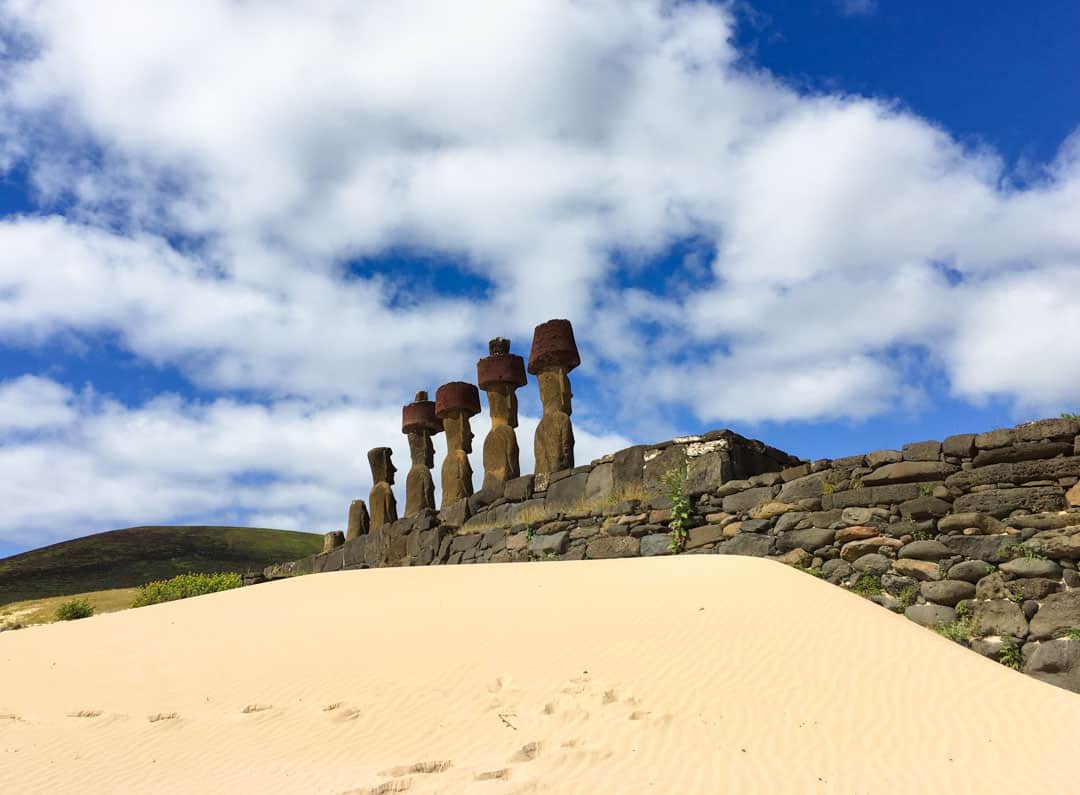
This is one of the island’s most popular spots, and it’s a gorgeous place to finish up our car tour of the northeast (again, we lucked out with very few people about on the day we visited).
There are some food and drink stalls if you’re after a late lunch or snack, otherwise, take your time and enjoy a wander of this serenely tropical scene. There’s plenty to linger for here.

You could stay on in this corner of the island and take in sunset at Anakena, or back at Tongariki. Otherwise, return to Hanga Roa via IPA1 through the centre of the island and enjoy sunset and dinner at another spot of your choice.
Travel Tip: Watch Out For The Wild Horses
When out and about on Easter Island, and particularly if you’re driving, and especially if you’re driving at night, keep an eye out for the island’s wild horses.
Horses were introduced here back in the 19th century by missionaries, and there are literally thousands of them wandering the island today, owned and branded, but free to roam. You’ll see them everywhere, including on the roads.
Day 5 – Road Trip Easter Island’s South & Southwest
Discover The Intrigues Of The Birdman Cult
We’ve got our hire car until 7pm tonight, so today, we’re going to be exploring the highlights of the island’s south and southwest.
Our first major destination today is Orongo Ceremonial Village, high up on the rim of the Rano Kau volcano on the southern tip of the island.
Orongo opens at 9am, so en route, make a stop at Ana Kai Tangata, a sea-side cave with ancient paintings high up the wall.
It’s thought that the cave, with its paintings of birds that were sacred to the island’s historic Birdman Cult, had some role to play in the annual Birdman competition (read on for more about this unusual challenge).
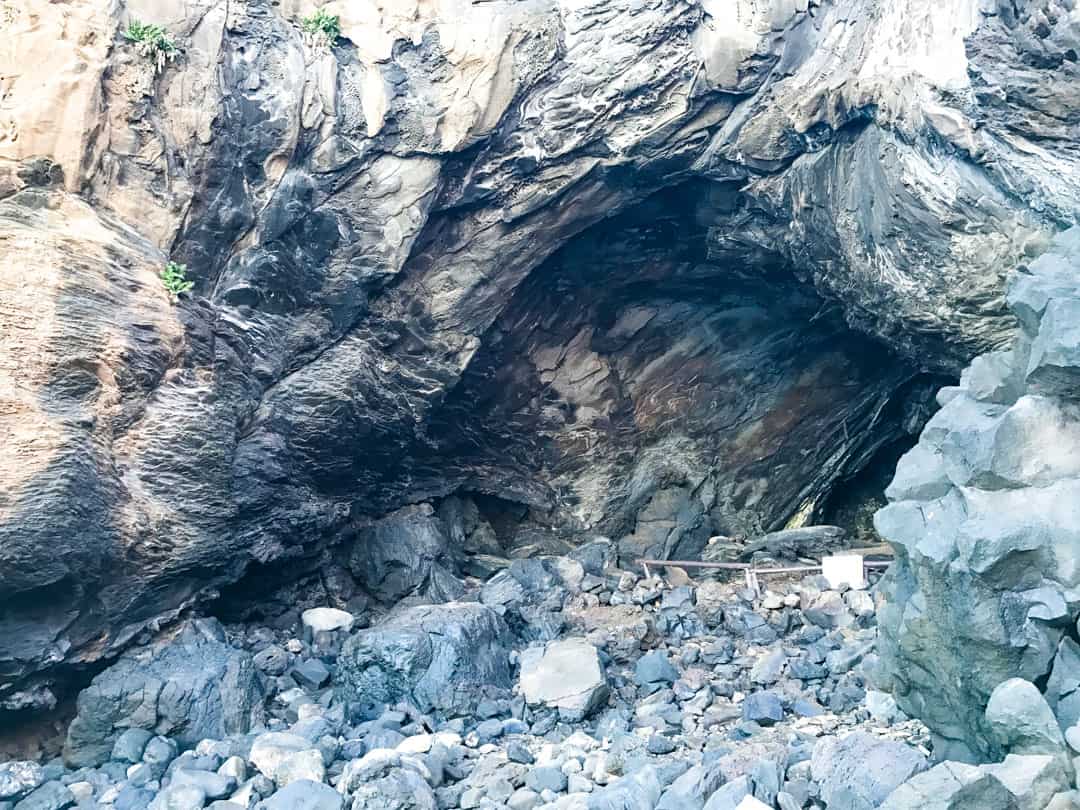
Head up to Orongo for opening, as the morning sun rises high over the island. The views en route over the great crater lake of Rano Kau – an extinct volcano – are spectacular.
Orongo is the one other place where your Rapa Nui National Park ticket is valid for one visit only, so again, take your time here. There’s loads to see, starting with the Birdman exhibition at the entrance.
From there, wander the precariously perched cliff-edge ceremonial village, with its clusters of grass-capped, stone houses with tiny doorways. Chiefs and competitors would stay in these huts during the Birdman competition and ceremony. Around the village, beautifully detailed petroglyphs cover the rocks.
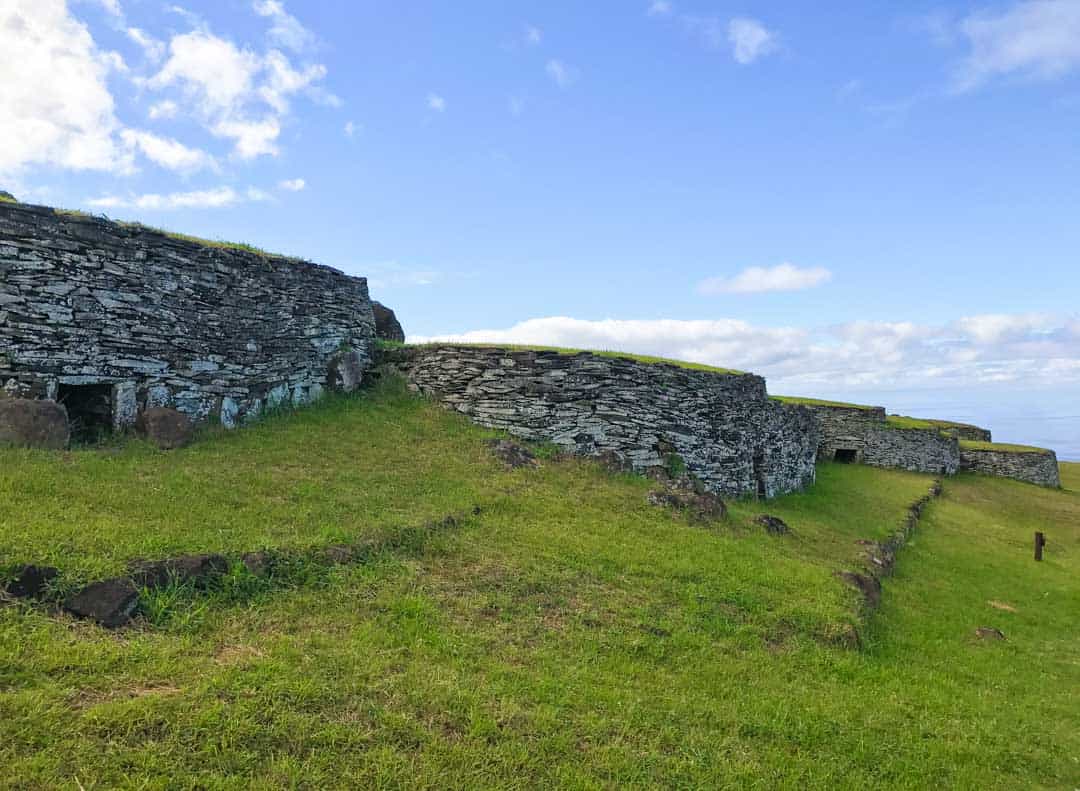
Orongo’s stone huts were perfectly positioned to watch over the tiny motus(islets) at the heart of the Birdman race for clan power: competitors representing each clan would swim out to the isles and wait for the first sooty tern egg of the season.
The first to find an egg and bring it safely back to the mainland would win for his chief the coveted Birdman title and island leadership for the next year.
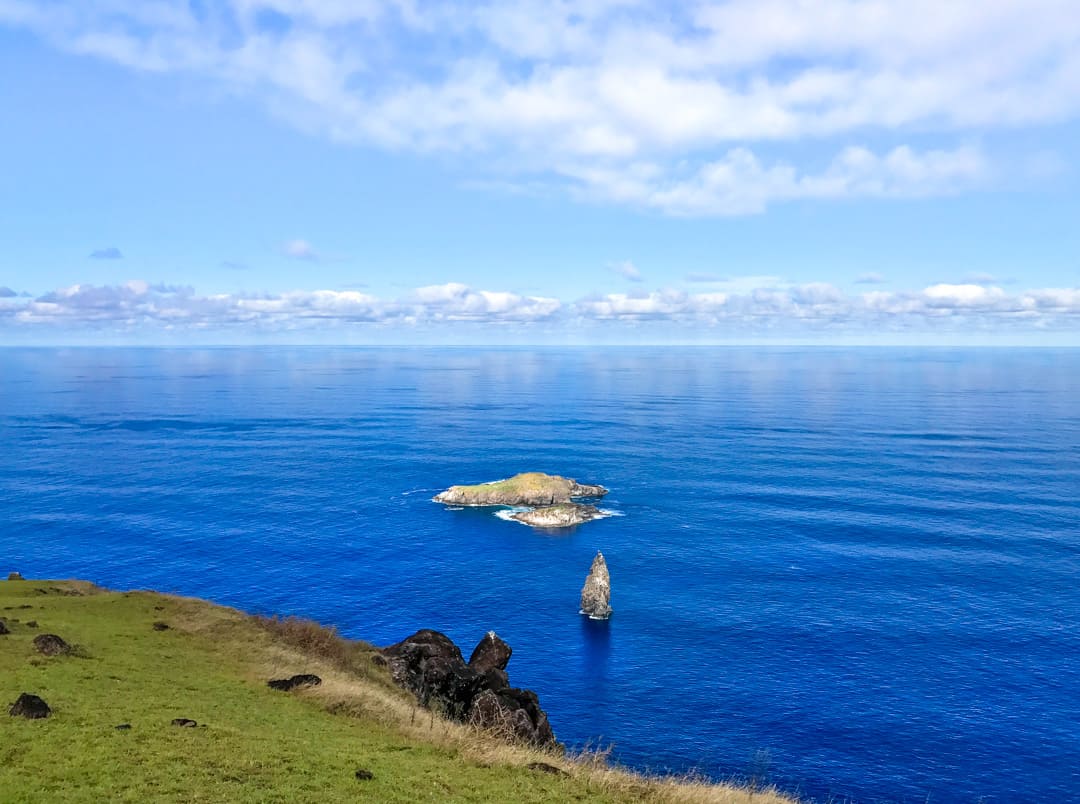
Journey Through The Past Along The South Coast
From Orongo, head back into Hanga Roa, turn right onto Hotu Matu’a and follow the road until you reach a sign for Vinapu. This is the first stop on our tour of the remnant ahu and moai of the south coast.
Highlights in this fascinating complex include a unique red stone ‘feminine’ moai, and an ahu platform built with such precision, it’s given rise to theories that there was contact between the Rapanui and their rock star contemporaries on the continent, the Incas.

From Vinapu, head northeast and onto the IPA2. This stretch of coast, though barely 15 minutes from town, feels entirely removed from civilisation. Make your way from the fallen giants at Ahu Hanga Te’e to the village ruins, stone ovens and moai of Ahu Akahanga.
We stopped constantly along this stretch of coast to investigate the atmospheric remains of stone platforms and broken, eroded moai. Haunting ruins and remnants of the ancient Rapanui literally scatter the rocky shore along here, from Vinapu all the way to Tongariki.
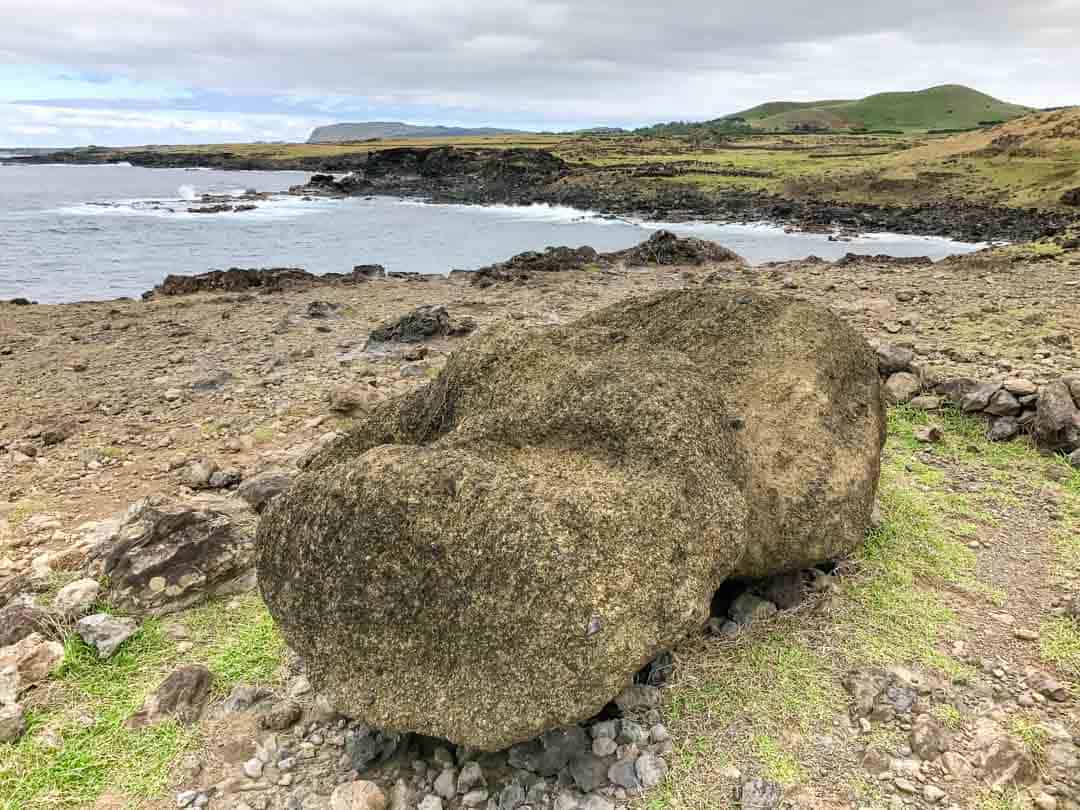
When you reach Tongariki again, stop for one more wander around the fifteen stone giants at this epic site (it’s impossible not to). Then make your way back towards Hanga Roa, turning right and travelling inland to reach the Camino Vaitea Anakena.
Explore A Moai Hat Factory
Our last stop for the day is the quarry of Puna Pau. This quirky site, in the crater of an old volcano, is where the Rapanui people sourced the red scoria rock they carved into pukao: the red hats that once capped the moai (some of the restored moai at Anakena, Tongariki and Tahai have donned their caps once more, but you’ll see the red stones lying around ahu sites all over the island).
Random pukao still scatter the site. It must have been something, watching the Rapanui people transport these giant lumps of red stone and raise them onto the heads of their giant moai.
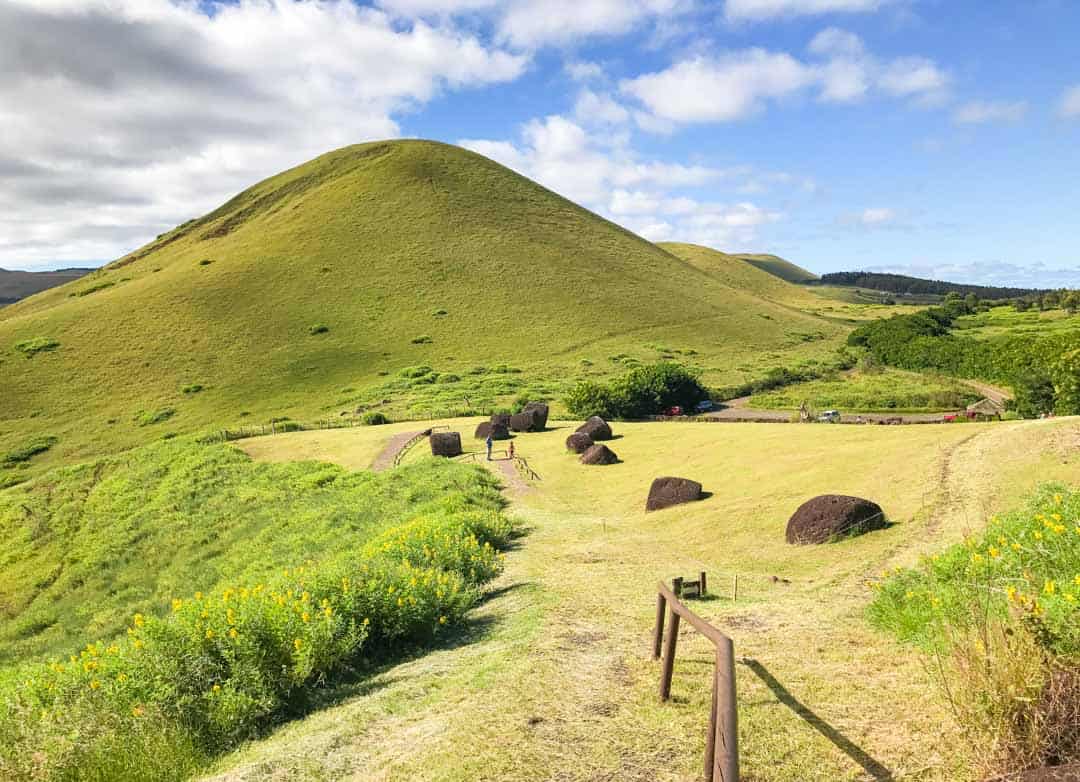
Our car hire ends this evening, so once the car has been collected or dropped off, set out for one last sunset before dinner.
Day 6 – A Morning At Easter Island’s Museum
Round Out Your Easter Island Itinerary
It’s our last morning on Easter Island, but if – like us – your flight doesn’t leave until mid-afternoon, there’s time for one last island highlight: the Sebastian Englert Anthropological Museum.
First though, sunrise. There was a full moon while we were on the island, so we were up extra early on our final morning to watch the glowing round orb dip towards the black sea, and the sun rise behind us over the moai of the Tahai complex one last time.
The Museum opens at 9.30am every day, except Monday when it’s closed, so if your last day is a Monday, hit up the museum at some other point during your stay.
Enjoy a leisurely morning and head over to the museum once you’ve checked out of your stay. You really only need an hour or two here. The museum – which is small but nicely set up – offers a fascinating round-up of the island’s history, its people and geology. It also has some exceptional historical, artistic and cultural pieces in the collection.

Farewell To The Moai
After lunch, it’s back to the airport and goodbye to this extraordinary little volcanic rock in the middle of the Pacific.
Six days might seem like a long time in a tiny place like this, but with so much history and intrigue packed into every corner of Easter Island, it’s just about enough time to get a taste for the place.
We’ll definitely be back, and next time for longer.

Good To Know
How To Get To Easter Island
The most straightforward way to get to Easter island, unless you’re visiting by cruise ship, is by plane. The only airline that services the island’s Mataveri International Airport is LATAM, with daily flights from Santiago in Chile, and weekly flights from Tahiti.
Do I Need A Visa For Easter Island?
As a territory of Chile, visa requirements for visiting Easter Island are the same as for visiting Chile – check your country’s travel advice for information specific to you.
In August 2018, the Chilean government introduced extra rules for visiting Easter Island, in an effort to balance the benefits of tourism with the resource and environmental limitations of the tiny island.
If you’re flying from Santiago, you now need to fill out a form when you check in for your flight in Santiago. You need to be able to show a return ticket, have appropriate ID, and your Easter Island accommodation booked. There are some small variations to the process if you’re flying from Tahiti or coming by cruise.
Visitors can now only stay on the island for 30 days max.
What Currency Is Used On Easter Island?
The currency used on Easter Island is the Chilean Peso. There are banks with ATMs in Hanga Roa. We had no trouble using these to withdraw cash.
How To Get Around Easter Island
You can explore Easter Island by foot, bicycle, ebike, motorbike, horse, quad bike, taxi and hire car.
Car and bike hire shops, and tour companies offering tours and organised travel around the island, cluster in downtown Hanga Roa.
There’s now a bus service too that does the run between Hanga Roa and Anakena at certain times throughout the day. It’s called the Te Ao Tour bus.
When Is The Best Time To Visit Easter Island?
Easter Island is warm pretty much year-round. Peak season is January to March, which is also summertime and the hottest time of the year (though it apparently never gets too nasty hot).
The best times to visit are April to June and October to December. We visited in May and while the days were quite warm, the evenings were really pleasant. This is the middle of the Pacific Ocean though and the weather can change quickly. Be ready for anything.
Want to know more? Send us your questions in the comments section below. If you’ve been, let us know what you loved most about magical Easter Island!

Hi very informative article! Did yiu have to hire a tour guide to visit some places? Or if you have a valid ticket, it wouldn’t be a problem? Thanks in advance.
Hi Jihye, thanks for your message and for your important question. We understand there is now a policy in place that requires all visitors to Easter Island to have a guide for all national park sites (which is effectively the entire island). Guides are mandatory, and payment for their services is in addition to the national park entry fee. We’ll be looking into this in more detail and updating our post accordingly as this policy wasn’t in place when we visited and it does significantly change the way you will explore and experience the island. For the latest information, we would suggest checking out this website and this online brochure. We wish you all the best with your travel planning!
Loved your itinerary. Were you able to get maps or information at the airport or at your accommodation? Is the grocery store in town fairly well stocked with items to make picnic lunches or breakfast?
Hi Brenda, thanks so much for your feedback! Things may have changed by the time Easter Island reopens to tourists (as at mid-April 2022, commercial flights still haven’t started back up), but when we visited, we were given a map of the island with info when we purchased our national park tickets at the airport. There was also tourist info at our accommodation.
There were several grocery stores in Hanga Roa when we were there; they weren’t large but we found what we needed for brekkies, lunches and a couple of dinners.
We hope you have a chance to visit this magic island! Happy travels!
Dan & John